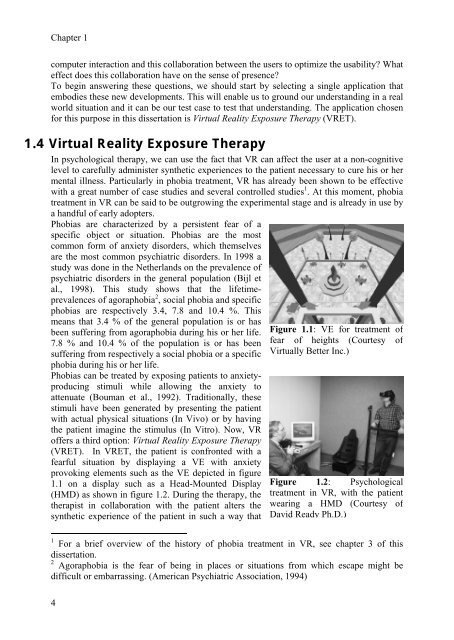Human-Computer Interaction and Presence in Virtual Reality
Human-Computer Interaction and Presence in Virtual Reality
Human-Computer Interaction and Presence in Virtual Reality
Create successful ePaper yourself
Turn your PDF publications into a flip-book with our unique Google optimized e-Paper software.
Chapter 1<br />
computer <strong>in</strong>teraction <strong>and</strong> this collaboration between the users to optimize the usability? What<br />
effect does this collaboration have on the sense of presence?<br />
To beg<strong>in</strong> answer<strong>in</strong>g these questions, we should start by select<strong>in</strong>g a s<strong>in</strong>gle application that<br />
embodies these new developments. This will enable us to ground our underst<strong>and</strong><strong>in</strong>g <strong>in</strong> a real<br />
world situation <strong>and</strong> it can be our test case to test that underst<strong>and</strong><strong>in</strong>g. The application chosen<br />
for this purpose <strong>in</strong> this dissertation is <strong>Virtual</strong> <strong>Reality</strong> Exposure Therapy (VRET).<br />
1.4 <strong>Virtual</strong> <strong>Reality</strong> Exposure Therapy<br />
In psychological therapy, we can use the fact that VR can affect the user at a non-cognitive<br />
level to carefully adm<strong>in</strong>ister synthetic experiences to the patient necessary to cure his or her<br />
mental illness. Particularly <strong>in</strong> phobia treatment, VR has already been shown to be effective<br />
with a great number of case studies <strong>and</strong> several controlled studies 1 . At this moment, phobia<br />
treatment <strong>in</strong> VR can be said to be outgrow<strong>in</strong>g the experimental stage <strong>and</strong> is already <strong>in</strong> use by<br />
a h<strong>and</strong>ful of early adopters.<br />
Phobias are characterized by a persistent fear of a<br />
specific object or situation. Phobias are the most<br />
common form of anxiety disorders, which themselves<br />
are the most common psychiatric disorders. In 1998 a<br />
study was done <strong>in</strong> the Netherl<strong>and</strong>s on the prevalence of<br />
psychiatric disorders <strong>in</strong> the general population (Bijl et<br />
al., 1998). This study shows that the lifetimeprevalences<br />
of agoraphobia 2 , social phobia <strong>and</strong> specific<br />
phobias are respectively 3.4, 7.8 <strong>and</strong> 10.4 %. This<br />
means that 3.4 % of the general population is or has<br />
been suffer<strong>in</strong>g from agoraphobia dur<strong>in</strong>g his or her life.<br />
7.8 % <strong>and</strong> 10.4 % of the population is or has been<br />
suffer<strong>in</strong>g from respectively a social phobia or a specific<br />
phobia dur<strong>in</strong>g his or her life.<br />
Phobias can be treated by expos<strong>in</strong>g patients to anxietyproduc<strong>in</strong>g<br />
stimuli while allow<strong>in</strong>g the anxiety to<br />
attenuate (Bouman et al., 1992). Traditionally, these<br />
stimuli have been generated by present<strong>in</strong>g the patient<br />
with actual physical situations (In Vivo) or by hav<strong>in</strong>g<br />
the patient imag<strong>in</strong>e the stimulus (In Vitro). Now, VR<br />
offers a third option: <strong>Virtual</strong> <strong>Reality</strong> Exposure Therapy<br />
(VRET). In VRET, the patient is confronted with a<br />
fearful situation by display<strong>in</strong>g a VE with anxiety<br />
provok<strong>in</strong>g elements such as the VE depicted <strong>in</strong> figure<br />
1.1 on a display such as a Head-Mounted Display<br />
(HMD) as shown <strong>in</strong> figure 1.2. Dur<strong>in</strong>g the therapy, the<br />
therapist <strong>in</strong> collaboration with the patient alters the<br />
synthetic experience of the patient <strong>in</strong> such a way that<br />
4<br />
Figure 1.1: VE for treatment of<br />
fear of heights (Courtesy of<br />
<strong>Virtual</strong>ly Better Inc.)<br />
Figure 1.2: Psychological<br />
treatment <strong>in</strong> VR, with the patient<br />
wear<strong>in</strong>g a HMD (Courtesy of<br />
David Ready Ph.D.)<br />
1<br />
For a brief overview of the history of phobia treatment <strong>in</strong> VR, see chapter 3 of this<br />
dissertation.<br />
2<br />
Agoraphobia is the fear of be<strong>in</strong>g <strong>in</strong> places or situations from which escape might be<br />
difficult or embarrass<strong>in</strong>g. (American Psychiatric Association, 1994)
















